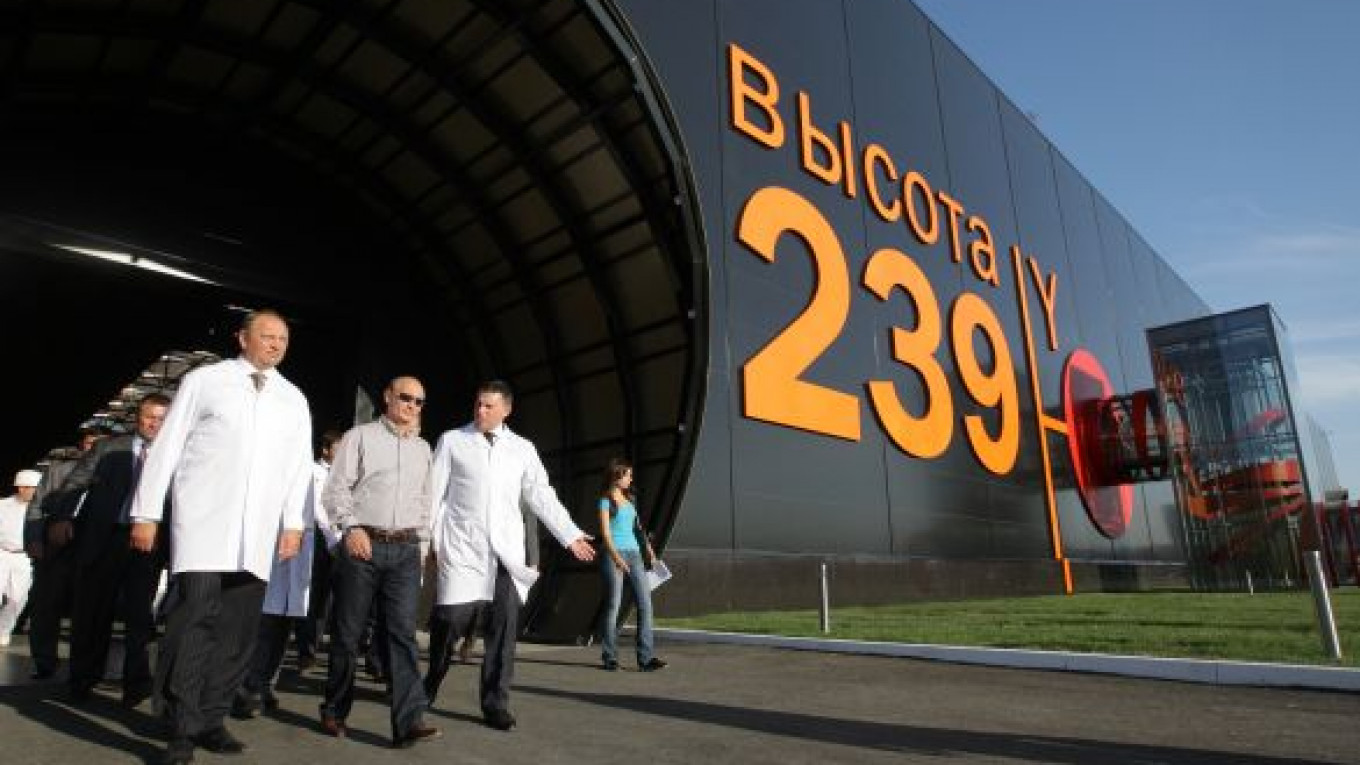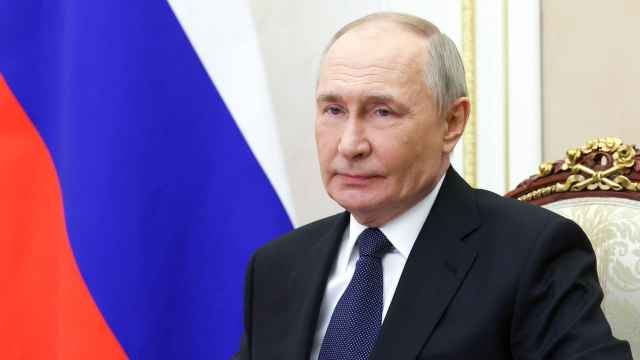In many Russian folk tales, a man is raised from the dead after he is doused in waters that heal his wounds and bring him back to life.
For the lifeblood of the Russian economy — oil and gas — it will be just as important to find a way to invigorate the service and equipment sector. In fact, innovation could prove to be the miracle water.
Right now "we don't have this kind of water," said Sergei Shatokhin, director of consulting firm Prefish in the Urals city of Tyumen. If competition with major international oil and gas services companies heats up — and such companies already have footholds in the Russian market — then companies here "won't buy our Russian products anymore," he said.
Russian companies must design new products, Shatokhin said, and they need an "upsurge of innovativeness."
For the Urals oil field services industry to thrive — or even survive — cutting-edge products and innovative practices will be needed, consultants and equipment makers said in interviews. Changes are already occurring: Increasingly tough physical conditions for extracting deposits and increasing competition from multinational companies are forcing the market to consider new approaches. In the next three years, for instance, Russian pipe producers plan to invest at least $5 billion in modernization, the Pipe Industry Development Fund lobbying group has announced.
Prodding an Industry
Oil field services companies offer the infrastructure, equipment and services necessary to extract and transport oil and gas. In the Urals, the manufacturing and maintenance of that equipment — rigs, drilling components, turbines, pipelines and more — is an important business.
The Urals Federal District leads the country in both oil and gas production, and it holds about 70 percent of Russia's oil reserves and 90 percent of its gas reserves, according to figures from Moscow-based consulting firm IRP Group. A number of major plants in the Urals, such as state enterprises Uralvagonzavod and the Elektrokhimpribor Combine, manufacture and make repairs on oil and gas extraction equipment. The Urals in general are known as Russia's industrial backbone.
But large-scale investment in the Russian oil field services industry began in earnest only in the past decade, and the sector as a whole lags behind its international competitors, Valentin Tazetdinov, managing director of ChelPipe's Vysota 239 factory, said in an interview. At the recently opened Chelyabinsk facility, Tazetdinov oversees the production of large-diameter pipes for oil and gas pipelines.
"Without innovation, we will simply be stunting the growth of the oil industry, including oil equipment manufacturing," Tazetdinov said. "We just aren't able to extract the oil and gas that is rushing freely in our country."
A number of companies have invested in innovative production practices and facilities, including ChelPipe, Russia's third-largest producer by production volume of oil and gas pipes. ChelPipe spent about $2 billion to construct Vysota 239 and the Iron Ozone 32 facility, which is about 50 kilometers outside Yekaterinburg, in Pervouralsk. Both facilities opened in 2010 and have new equipment, a work approach based on the Japanese practice of kaizen and a number of aggressive staff policies, such as daily breathalyzer alcohol testing of employees and programs for discouraging smoking.
Pushin said the 'newborn demand forced domestic companies to pay attention to innovative products.'
The second-largest Russian producer of steel pipes, OMK, also cites innovation as a key part of its growth strategy and says it is spending more on modernization. In the Urals, OMK makes pipeline fittings at its Trubodetal factory in Chelyabinsk.
Yet, consultants and producers said the Russian oil field services industry as a whole is facing serious hurdles: a deficit of skilled young employees, aging equipment and a lack of financial help from the regional governments.
"For now, [innovation] is insufficient to the extreme," Shatokhin said from Tyumen. "There's no plan for innovation."
"It's easier for companies to cruise along the rails they're already going along," he said.
Urals oil and gas services plants face competition from multinationals providing oil field services in the region. Those include Baker Hughes, Halliburton, Schlumberger, Weatherford International and Total. Notably, Schlumberger has built manufacturing plants in Bashkortostan and Tyumen, Weatherford has production in Usinsk, and Baker Hughes plans to set up production in Tyumen.
Multinational Contest
The entry of foreign companies into the oil and gas services market forced domestic producers to begin thinking innovatively, noted Mikhail Pushin, commercial director at Izhevsk's NPF Mekhanik, which produces pump assemblies and components.
"Until recently, the market was very conservative and didn't adopt anything new," Pushin said by e-mail.
That changed with the arrival of the multinationals, which offered services for borehole maintenance that had been impossible to perform with domestic equipment, he explained. In West Siberia, which is included in the Urals Federal District, most wells have been in operation for some time, and the boreholes, or holes drilled for extraction, are old.
As a result, the services offered by the multinationals — such as cementing boreholes, or offering hydraulic fracturing — quickly attracted demand from Russian companies.
"This newborn demand forced domestic companies to pay attention to innovative products and, accordingly, forced us to manufacture them," Pushin said.
The Tyumen region is a case study. A hub for gas- and oil-related technologies since Soviet times, the southern Urals region is now an example of what needs fixing. Up to 70 percent of equipment in the region is worn out, and up to 90 percent is low-quality or outdated, Shatokhin estimated.
It's no surprise, then, that a development plan for oil field services in the Tyumen region — commissioned by the government and drafted not long ago by the Prefish firm — suggested revamping the region's machine manufacturing by introducing new products.
Meanwhile, oil and gas extraction is progressing from more-accessible to less-accessible deposits, which in turn is driving the demand for new technologies.
4 Kilometers Below
For example, with oil companies drilling more often in the ocean and north of the Arctic Circle, the extraction pipes must be able to withstand temperatures ranging from minus 60 degrees Celsius to plus 50 C, as well as depths of up to four kilometers below sea level, according to pipemakers.
"Current conditions for oil and gas extraction get more complicated every year," Tazetdinov said.
For all of these reasons, pipe producers are spending heavily on new technologies and facilities. During the past eight years, Russian pipemakers invested $10 billion in the development and modernization of production, according to the Pipe Industry Development Fund.
OMK put 21 billion rubles ($752 million) into the modernization of its production facilities last year and plans to invest 33 billion rubles this year, said OMK spokesman Vladimir Stepanov.
"Investment in new technologies is part of OMK's strategy, which is directed toward the creation of a vertically integrated company, increased production efficiency and the reduction of costs," Stepanov said by e-mail.
At ChelPipe and OMK, a lot of innovation spending has been devoted to ramping up production of large-diameter pipes, which can range from 508 millimeters to 1,420 millimeters in diameter. Of the 13.5 million tons of pipes produced annually in Russia, 5 million tons are large-diameter pipe, the Pipe Industry Development Fund said in December.
In 2005, OMK became the first Russian company to produce large-diameter pipe. It set up a production line even though no buyers — not even industry giant Gazprom — were guaranteeing future purchase of the product, Stepanov said.
He said the risk paid off when OMK won a tender to supply pipe for Nord Stream, the multinational gas pipeline project in the Baltic Sea that is spearheaded by Gazprom. (For Nord Stream's second pipeline, OMK is supplying large-diameter pipes along with Germany's Europipe and Japan's Sumitomo.)
"Innovation lies in implementing unique technologies and predicting demand for high-tech production," Stepanov said.
ChelPipe's large-diameter pipe facility in Chelyabinsk also has taken investment risks. Although ChelPipe didn't add customers by opening Vysota 239, it did win new orders, a spokesman said. The company has spent about $10 million to $15 million on research and development for large-diameter pipe, said Tazetdinov, Vysota 239's managing director.
'Innovation lies in implementing unique technologies and predicting demand for high-tech production,' OMK's Stepanov said.
ChelPipe plans to eventually produce seamless pipe, an even more advanced technology, but this will require significant investment, ChelPipe's spokesman said.
Rivalry isn't the only impetus for creating new technologies. Having foreign and Russian companies working in a single hub can encourage innovation, according to Shatokhin. Oil and gas operations often cluster around multinational companies, and those operations can attract local companies, leading to more domestic competition.
Such a cluster is forming in Tyumen, where Schlumberger and other foreign companies have offices and production operations, Shatokhin said. He pointed to Tyumenskiye Motorostroiteli, a group of enterprises led by Gazturboservis — the "flagship" innovative oil field services company in the region — and situated at the Tyumen Motor Factory.
For Gazturboservis, which produces and repairs turbines, innovation plays a key role in its development strategy, said spokesman Yevgeny Alexeyev. The company has implemented new methods of production, new control systems and a new technology for making parts out of moulds and casts. Its main customer, Gazprom, and other buyers have benefited from the innovations, he said.
"They like it when work is faster and higher-quality," Alexeyev explained.
Yet, there are some barriers in the way of more innovation in oil field services. Shatokhin, for one, lamented the lack of government funding. Although government benefits in Tyumen decrease the cost of domestically produced equipment by about 8 percent, government aid is insufficient, he said. He estimated that less than 1 percent of Tyumen's gross regional product is spent on innovation.
ChelPipe has enjoyed government aid, including a loan from Gazprombank that was approved only after the government guaranteed the loan for one year, Tazetdinov said. He said the company "worked very seriously" on building a relationship with the government. In addition to the loan itself, proof of that relationship came in the form of a photo op: Prime Minister Vladimir Putin attended the ceremonial openings of both Vysota 239 in July 2010 and Iron Ozone 32 in November 2010.
Innovations vs. Actions
Tightfistedness on the part of Russian oil and gas customers is the main impediment to innovation, said Pushin of NPF Mekhanik. Domestic oil and gas firms often spend as little as possible on products, without regard to the quality of the technology that they are buying, he said.
He added that although equipment producers can carry out research and development, Russian industry lacks the capacity to manufacture innovative products, at least in the pumping sphere. Innovation-minded companies must buy equipment from abroad, which exposes them to administrative barriers in the form of customs-related costs, as well as tax audits. And foreign producers aren't keen on keeping inventory in Russia.
In any part of the oil field services industry, it comes down to competition, Pushin noted: Domestic companies aren't interested in innovation until "real competition" — usually provided by foreign players — enters the market and threatens to force them out.
"Our area desperately needs innovative finished products because [foreign] competition has appeared in our sales market. So, it's a question of survival," Pushin said.
| Company | Total Pipe Sales 2010 | Large-Diameter Pipe Sold (Thousands of Tons) |
| TMK | 33% | 671 |
| Vyksa Steel (OMK) | 23% | 1,300 |
| ChelPipe | 16% | 600 |
| Izhora Pipe (Severstal) | 5% | 471 |
| Other | 23% | — |
Source: Compiled by Andrei Lobazov, Alfa Bank Research, in July 2011.
A Message from The Moscow Times:
Dear readers,
We are facing unprecedented challenges. Russia's Prosecutor General's Office has designated The Moscow Times as an "undesirable" organization, criminalizing our work and putting our staff at risk of prosecution. This follows our earlier unjust labeling as a "foreign agent."
These actions are direct attempts to silence independent journalism in Russia. The authorities claim our work "discredits the decisions of the Russian leadership." We see things differently: we strive to provide accurate, unbiased reporting on Russia.
We, the journalists of The Moscow Times, refuse to be silenced. But to continue our work, we need your help.
Your support, no matter how small, makes a world of difference. If you can, please support us monthly starting from just $2. It's quick to set up, and every contribution makes a significant impact.
By supporting The Moscow Times, you're defending open, independent journalism in the face of repression. Thank you for standing with us.
Remind me later.






